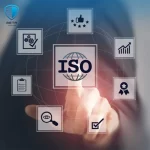Implementing ISO 27001 in your organization is a critical step towards ensuring the confidentiality, integrity, and availability of your information assets. ISO 27001 is an internationally recognized standard for information cyber security management systems, providing a systematic approach to managing sensitive company information. With cyber threats on the rise and data breaches becoming more common, organizations must take proactive measures to protect their data and comply with regulatory requirements.

What is ISO 27001 and why is it important?
ISO 27001 is an international standard that sets out the criteria for establishing, implementing, maintaining, and continually improving an information security management system (ISMS) within the context of the organization. It provides a systematic approach to managing sensitive company information, ensuring its confidentiality, integrity, and availability.
Implementing ISO 27001 is crucial for several reasons. First and foremost, it helps organizations protect their information assets from various security threats, including cyber attacks, data breaches, and unauthorized access. By implementing the standard’s best practices, organizations can identify and mitigate potential risks, ensuring the security and privacy of their data.
Moreover, ISO 27001 compliance helps organizations demonstrate their commitment to information security to clients, partners, and regulatory bodies. It enhances the organization’s reputation and builds trust among stakeholders, which is increasingly important in today’s digital world.
Assessing your organization’s readiness for ISO 27001
Before diving into the implementation process of ISO 27001, it is crucial to assess your organization’s readiness for this standard. This step will help you identify any gaps or areas for improvement before starting the implementation journey.
Start by conducting a thorough review of your current information security practices and policies. This review should encompass all aspects of your organization, including technology infrastructure, human resources, and physical security measures.
Next, compare your existing practices with the requirements outlined in ISO 27001. This will allow you to determine whether your organization is already implementing some of the necessary controls or if there is a substantial amount of work ahead.
Additionally, you should establish a team dedicated to overseeing the implementation process to continuous monitoring cyber security. This team should consist of individuals from various departments within your organization who have experience and knowledge in information security.
Creating ISO 27001 implementation plan
Creating ISO 27001 implementation plan is essential for the successful adoption of this information security standard in your organization. This plan will serve as a roadmap that outlines the necessary steps, timelines, and responsibilities for each stage of the implementation process.
To create a robust implementation plan, start by identifying and prioritizing the key objectives you want to achieve with ISO 27001. These objectives should align with your organization’s overall business goals and address the specific security risks and challenges you face.
Once you have identified your objectives, break down the implementation process into manageable phases. Each phase should have clear objectives, deliverables, and timelines. Consider involving key stakeholders and experts from different departments to ensure a holistic approach and gain buy-in from all levels of the organization.
As you develop your plan, allocate resources, including budget, personnel, and technology, to support the implementation process. It’s crucial to have dedicated personnel who will oversee the implementation effort and ensure its smooth execution.
Lastly, communicate the implementation plan to all relevant stakeholders, including employees, management, and external partners. This will create awareness and instill a sense of ownership and accountability throughout the organization.
Engaging top management and key stakeholders
In order to gain support and commitment, it is essential to communicate the benefits of ISO 27001 and the importance of information security to top management. This can be achieved by highlighting the potential risks and consequences of data breaches and emphasizing the positive impact that ISO 27001 can have on the organization’s reputation and bottom line.
Additionally, involving key stakeholders from different departments will ensure that all aspects of the organization’s operations are considered during the implementation process. This collaboration will help identify any potential barriers or challenges that need to be addressed and allow for the development of tailored solutions. Creating a sense of ownership among stakeholders will also increase their willingness to actively participate and contribute to the implementation effort.
Building an effective information security management system (ISMS)
To build an effective ISMS, you need to have a clear understanding of the organization’s objectives, processes, and the information assets that need to be protected. This includes identifying all potential vulnerabilities and threats that could compromise the confidentiality, integrity, and availability of these assets.
Once the risks are identified, you can prioritize them based on their impact and likelihood. This will help you allocate resources effectively and implement the necessary controls to mitigate the risks. It is important to note that the ISMS should be a continuous process that is regularly reviewed, updated, and improved.
Conducting risk assessments and identifying controls
Conducting risk assessments is a crucial aspect of implementing ISO 27001 in your organization. By understanding and evaluating potential security risks, you can effectively allocate resources and implement the necessary controls to protect your information assets.
To begin the risk assessment process, it is essential to identify all possible threats and vulnerabilities that your organization may face. This includes conducting a thorough analysis of your organization’s systems, processes, and assets. By doing so, you can gain insight into the potential impact and likelihood of each risk.
Once you have identified the risks, it is important to prioritize them based on their severity and likelihood of occurrence. This will help you allocate resources efficiently and address the most critical risks first.
After prioritizing the risks, the next step is to identify and implement the appropriate controls. These controls can include technical measures, such as firewalls and encryption, as well as organizational measures, such as policies and procedures.
It is crucial to note that the controls should be tailored to your organization’s specific needs and requirements. A one-size-fits-all approach may not be suitable for every organization. Additionally, the controls should be regularly reviewed and updated to adapt to changing threats and technologies.
Training employees on ISO 27001 requirements and best practices
Employees play a significant role in ensuring the security of your organization’s information assets. Therefore, it is essential to provide them with the necessary knowledge and skills to effectively execute their responsibilities.
Start by conducting an assessment to identify the training needs of your employees. This can be done by evaluating their current knowledge and understanding of ISO 27001 requirements, as well as their roles and responsibilities within the ISMS.
Next, develop a training program that covers the key principles, objectives, and requirements of ISO 27001. This should include topics such as risk management, incident response, access control, and awareness of security threats.
Ensure that the training materials are clear, concise, and tailored to the different roles and responsibilities within your organization. Provide practical examples and case studies to help employees understand how the guidelines can be applied in their day-to-day activities.
Regularly schedule training sessions and workshops to keep employees updated on any changes or updates to the ISO 27001 standard. This will help maintain a culture of continuous improvement and ensure that employees are always aware of the best practices for information security.
By investing in employee training, you can create a knowledgeable and security-conscious workforce that actively contributes to the success of your ISMS. Stay tuned for the next section, where we will explore strategies for conducting effective employee training sessions and measuring their effectiveness.
Implementing and monitoring ISO 27001 controls and policies
Implementing and monitoring ISO 27001 controls and policies is a critical aspect of successfully implementing and maintaining an Information Security Management System (ISMS) in your organization.
Once your employees are trained and equipped with the necessary knowledge and skills, the next step is to implement the controls and policies outlined in the ISO 27001 standard. These controls and policies are designed to address specific risks and vulnerabilities within your organization’s information assets.
Start by conducting a thorough risk assessment to identify the potential risks and vulnerabilities that need to be mitigated. This will help you determine which controls and policies are most relevant and effective for your organization.
Next, develop a detailed implementation plan that outlines the steps, responsibilities, and timelines for implementing each control and policy. Assign specific roles and responsibilities to individuals or teams within your organization to ensure accountability and effective implementation.
Regularly monitor the effectiveness of the implemented controls and policies by conducting internal audits and assessments. This will help identify any gaps or areas for improvement and allow you to take corrective actions.
Conducting internal audits and management reviews
In order to ensure the effectiveness of your implemented ISO 27001 controls and policies, it is crucial to conduct regular internal audits and management reviews. These processes help to evaluate the performance of your Information Security Management System (ISMS) and identify any areas that require improvement or corrective actions.
Internal audits, conducted by trained and impartial auditors within your organization, aim to assess the compliance of your ISMS with the ISO 27001 standard and the effectiveness of your implemented controls and policies. This involves reviewing documentation, procedures, and practices, as well as interviewing employees to gauge their understanding and adherence to the ISMS.
Management reviews, on the other hand, involve the top management of your organization evaluating the overall performance and effectiveness of the ISMS. This includes analyzing the results of internal audits, tracking progress towards achieving objectives, and ensuring that resources are allocated appropriately.
Achieving ISO 27001 certification and maintaining compliance
Achieving ISO 27001 certification is a significant milestone for any organization. It not only demonstrates your commitment to information security but also provides a competitive edge in today’s digital landscape. However, obtaining certification is just the beginning. To truly benefit from ISO 27001, it is essential to maintain compliance with the standard.
Maintaining compliance requires a proactive approach and ongoing commitment from all levels of the organization. Regularly reviewing your ISMS, conducting internal audits, and management reviews are vital in identifying any gaps or non-conformities that may arise over time.
Meta Techs and ISO 27001 Compliance
Expert Guidance
MetaTechs recognizes the critical role that ISO 27001 plays in ensuring a robust security framework. Their team of experts provides comprehensive guidance to organizations seeking ISO 27001 certification. From initial assessment to implementation and maintenance, Meta_Techs offers a roadmap tailored to the unique needs of each client.
Tailored Solutions
One size does not fit all when it comes to information security. Meta Techs understands this and tailors its ISO 27001 compliance solutions to the specific requirements of the client. This ensures that the implementation of security measures aligns seamlessly with existing business processes.
Continuous Improvement
ISO 27001 is not a one-time achievement; it requires ongoing commitment to continuous improvement. MetaTechs goes beyond initial certification, offering support in maintaining and enhancing the ISMS. This approach ensures that organizations remain resilient against emerging cyber threats.
Conclusion: The benefits of ISO 27001 implementation for your organization
Implementing ISO 27001 can bring numerous advantages to your organization. The primary benefit is enhanced information security, as the standard provides framework for identifying, managing, and mitigating risks. By implementing ISO 27001, you demonstrate your commitment to protecting sensitive data and ensuring confidentiality, integrity, and availability.
ISO 27001 certification also enhances your organization’s reputation, instilling trust and confidence in customers, partners, and stakeholders. This can lead to increased business opportunities and a competitive edge in the market.
Related posts:
 What Is ISO 27001?, Core Principles, Benefits, and Requirements
What Is ISO 27001?, Core Principles, Benefits, and Requirements
 What is Content Delivery Network ? A Comprehensive Guide
What is Content Delivery Network ? A Comprehensive Guide
 Malware Detection and Removal Essentials
Malware Detection and Removal Essentials
 What is the cyber security compromise assessment ?
What is the cyber security compromise assessment ?
 importance of cyber security awareness training for employees
importance of cyber security awareness training for employees
 continuous monitoring cyber security
continuous monitoring cyber security

